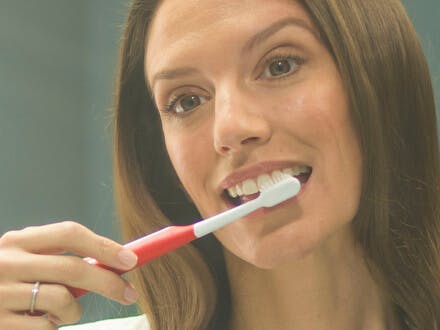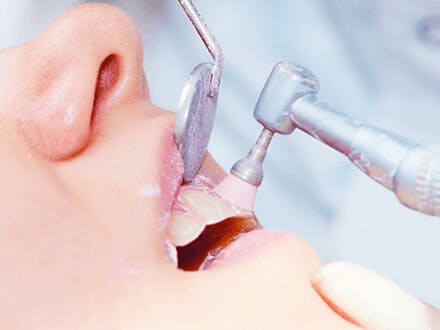Gum disease – also known as periodontal disease – is a common bacterial infection of the gums. Plaque bacteria and tartar build up on the teeth and along and below the gum line. This causes inflammation and can eventually erode the gum tissue and bone that supports the teeth.i
According to the Centers for Disease Control and Prevention (CDC), one in two American adults over the age of 30 have some form of gum disease. It’s generally caused by poor oral hygiene and can even lead to tooth loss if left untreated.i Gum problems can be identified by changes to the appearance of the teeth and gums, as well as less visible signs such as bad breath, pain or soreness, and a foul taste in the mouth.
Gum Disease Symptoms
Typically, healthy gums don’t hurt and healthy gums don’t bleed. Bleeding gums could very well be an early sign of gum disease.
The symptoms of gum disease vary depending on the stage and severity of the infection, but they can include:ii
- Sore or irritated gums
- Red, purplish or swollen gums
- Gums that bleed easily, particularly when brushing
- Receding gums
- Bad breath
- A foul taste in the mouth
- New gaps between the teeth
- Gaps between tooth and gum
- Gum ulcers or abscesses
- Pus around the teeth and gums
- Loose teeth or loss of a tooth
- Gum pain when chewing
- A change in the way teeth fit together
What Does Gum Disease Look Like?
One of the most obvious warning sign of gum disease is noticing any blood when you brush your teeth. You should also look out for any changes to the appearance of your smile.
Healthy gums are light pink in color and feel firm to the touch, while those affected by gum disease will change to a darker pink, red, or even purple color as the infection develops - and receding gums can cause teeth to look longer.
You might also notice new gaps appearing in your smile or a gap between the tooth and gum. Your teeth and gums may also begin to feel looser. When gums recede or pull away from your teeth, gaps – or ‘pockets’ - may form. If left untreated, bacteria can collect in these pockets, which can lead to the formation of gum abscesses.
How Do You Get Gum Disease?
In most cases, gum disease is caused by poor oral hygiene – not brushing and flossing regularly or thoroughly enough.
Plaque is a sticky film that contains bacteria, which forms on the teeth and is removed by brushing and flossing. If plaque is allowed to build up, it forms a harder substance along and below the gum line called tartar, which can't be removed by brushing or flossing alone.ii
The bacteria in plaque can cause an infection, which can progress over time if left untreated,eventually leading to gum inflammation and ultimately eroding the tissue and bones (periodontium) that support the teeth.ii
Besides poor oral hygiene, a number of other factors can put you at higher risk for the development of gum disease. These can include:ii
- Hormonal changes, such as during pregnancy and menopause
- Illnesses that cause a decrease in your body’s immunity, such as cancer or HIV
- Smoking or chewing tobacco
- Certain medications that cause a dry mouth
- Genetics
- Conditions such as diabetes, rheumatoid arthritis and Crohn's disease
- Poor nutrition, particularly a deficiency in Vitamin C
Gum Disease Stages
Gum disease is progressive, but thankfully it can be reversed if caught early enough in its first and mildest stage – gingivitis.ii
Gingivitis is a mild form of gum disease that causes redness, swelling and bleeding in the gums. If left untreated, however, gingivitis can progress to mild, moderate and eventually severe periodontitis. This happens when ongoing gum inflammation (a result of too much plaque and tartar buildup) causes bacteria to form between your gums and teeth. Eventually, this can lead to deep infections that may cause a loss of gum tissue and bone – and potentially one or more teeth.ii
Learn more about each of the stages of gum disease.
Gum Disease Prevention
The best way to deal with gum disease is to prevent it from ever taking hold. You can do this by maintaining a good oral health regime – gently brushing your teeth for two minutes twice a day, angling your toothbrush to include the gum line and flossing or using interdental brushes to clean between the teeth. It's also important to visit the dentist regularly, every 6-12 months.iii

Gum Disease Treatment Options
Cleaning by a dental professional is the only way to remove tartar build up. More advanced gum disease treatments such as scaling and root planning, laser treatment, or gingival flap surgery may be necessary to remove bacteria and tartar from deep pockets and, in the more severe cases, bone grafting to restore lost bone. iv
Gum Disease - Next Steps
Periodontal disease is a progressive condition with potentially serious effects, so it's important to keep your gums healthy. Visit your dentist regularly, and see them immediately if you experience any early gum disease symptoms, such as gingivitis. When you see your dentist, ask about a gum health toothpaste such as parodontax.
SOURCES
By clicking any of the links below you will be taken to an external website that is independently operated and not managed by GSK. GSK assumes no responsibility for the content on the website. If you do not wish to leave this website, do not click on the links below.
- CDC: Half Of American Adults Have Periodontal Disease. American Academy of Periodontology. https://www.perio.org/consumer/cdc-study.htm. Accessed 06/25/19.
- Periodontitis (Symptoms & causes). Mayo Clinic. https://www.mayoclinic.org/diseases-conditions/periodontitis/symptoms-causes/syc-20354473. Accessed 19/12/19.
- Preventing Periodontal Disease. American Academy or Periodontology. https://www.perio.org/consumer/prevent-gum-disease. Accessed 19/12/19.
- Periodontitis (Diagnosis & treatment). Mayo Clinic. https://www.mayoclinic.org/diseases-conditions/periodontitis/diagnosis-treatment/drc-20354479. Accessed 19/12/19.
How parodontax Toothpaste Works
parodontaxTM is a toothpaste that is clinically proven to help reduce bleeding gums. When used twice daily, it significantly reduces plaque and bleeding gums after 12 weeks.





